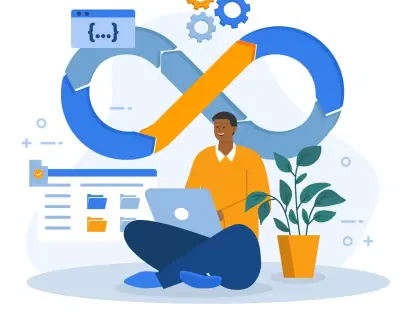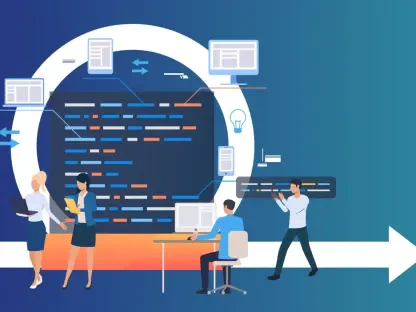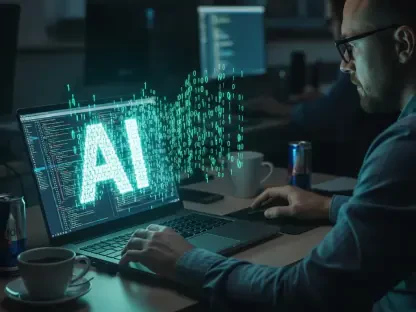The Current Landscape of AI in Software Development
The software development industry stands at a pivotal moment where artificial intelligence (AI) is no longer just an experimental concept but a core component of everyday workflows, transforming how developers approach their craft. With over half of developers reportedly using AI tools for various tasks, the integration of these technologies has become a defining factor in boosting productivity and driving innovation. From startups to tech giants, companies are leveraging AI to streamline processes, marking a significant shift in how software is conceptualized, built, and maintained.
AI’s influence spans the entire development lifecycle, touching planning, coding, testing, deployment, collaboration, and maintenance. In planning, tools analyze requirements and predict project timelines, while in coding, they offer real-time suggestions and error detection. Testing benefits from automated case generation, deployment sees smoother releases through predictive analytics, collaboration improves with enhanced communication, and maintenance becomes proactive with issue detection. This comprehensive reach ensures that no stage of development remains untouched by AI’s capabilities.
Key players like Vibe Solutions and Rocket.new exemplify the power of AI-driven platforms in transforming workflows. Vibe Solutions integrates AI across all phases, fostering seamless team synergy, while Rocket.new converts design concepts into production-ready code with remarkable speed. The growing significance of AI lies in its ability to enhance efficiency and creativity, positioning it as an indispensable tool for developers aiming to stay competitive in a fast-evolving industry.
Key Trends and Innovations in AI-Driven Development
Emerging Technologies and Workflow Enhancements
AI is reshaping software development through cutting-edge trends such as automation of repetitive tasks, predictive analytics, and context-aware code suggestions. Automation handles mundane activities like formatting and basic testing, freeing developers to tackle complex challenges. Predictive tools forecast potential bugs or project delays, while smart suggestions adapt to the specific context of a project, ensuring relevance and accuracy in code generation.
Beyond efficiency, AI fosters collaboration and creativity by bridging gaps between technical and non-technical team members. It translates complex ideas into accessible insights and offers instant feedback during reviews, enabling teams to iterate faster. This shift allows developers to focus on strategic problem-solving rather than getting bogged down by routine work, ultimately enhancing the quality of software solutions.
Innovations like end-to-end automation and unified platforms further streamline workflows by reducing the need for multiple tools. These advancements create cohesive environments where planning, coding, and deployment occur seamlessly. For developers, this opens new opportunities to deliver projects faster and craft user experiences that are more intuitive, pushing the boundaries of what software can achieve.
Market Growth and Adoption Insights
The adoption of AI tools in software development is accelerating at an unprecedented pace, with recent surveys indicating that nearly 60% of developers now rely on such technologies for at least one aspect of their work. This widespread acceptance reflects a growing trust in AI’s ability to improve outcomes. From small teams to large enterprises, the integration of these tools is becoming standard practice across the industry.
Market projections suggest significant growth for AI-integrated platforms over the coming years, with estimates predicting a doubling of their market share by 2027. This expansion is expected to slash development timelines by up to 30% and reduce costs considerably, making AI a critical investment for companies seeking efficiency. The data points to a future where AI is not just an option but a necessity for staying relevant.
Looking ahead, adoption rates are anticipated to climb even higher as developers increasingly demand tools that address specific pain points like debugging and collaboration. The trend indicates a shift toward more tailored solutions that cater to niche needs within the development process. As these tools evolve, their impact on productivity and innovation will likely deepen, reshaping the competitive landscape.
Challenges in Integrating AI into Developer Workflows
Implementing AI into development workflows is not without hurdles, particularly when it comes to aligning tools with unique project contexts. Generic AI solutions often struggle to adapt to specialized requirements, leading to inefficiencies or irrelevant outputs. Developers must customize these tools or risk over-reliance on automation, which can stifle critical thinking and introduce errors if not monitored closely.
Another pressing challenge lies in the skill gaps among developers unfamiliar with AI platforms. The learning curve associated with mastering new systems can slow down adoption, especially for teams lacking access to adequate training. This disparity risks creating uneven progress within the industry, where only well-resourced organizations fully benefit from AI’s potential, leaving smaller players at a disadvantage.
Data privacy and security concerns also loom large, especially when AI tools analyze sensitive codebases or monitor user behavior. Without stringent safeguards, there is a risk of breaches or misuse of information, undermining trust in these technologies. To address these issues, strategies like comprehensive training programs, hybrid human-AI oversight, and robust encryption protocols are essential to ensure safe and effective integration.
Regulatory and Ethical Considerations for AI in Development
The regulatory landscape surrounding AI in software development is complex, with data protection laws becoming increasingly stringent. Compliance with standards like GDPR is critical when AI tools process personal or proprietary information. Additionally, intellectual property concerns arise over ownership of AI-generated code, creating legal gray areas that demand clear guidelines to protect developers and organizations alike.
Transparency in AI decision-making processes is another vital consideration to maintain trust and accountability. Developers and stakeholders need insight into how algorithms arrive at suggestions or automate tasks to prevent unintended consequences. Adhering to industry standards ensures that AI tools are not only effective but also aligned with broader ethical and legal expectations, fostering responsible use.
Ethical implications, such as the potential for bias in AI outputs, require ongoing human oversight to mitigate risks. Ensuring fairness in automated suggestions or decisions is paramount to avoid perpetuating systemic inequities. As regulations evolve, they will likely shape the pace and direction of AI adoption, balancing innovation with accountability to safeguard the integrity of development practices.
The Future of AI in Shaping Developer Workflows
AI holds immense potential to create hyper-personalized developer environments that adapt to individual habits, preferences, and strengths. Such customization could optimize productivity by tailoring interfaces and suggestions to specific workflows. This level of personalization promises to make development more intuitive, reducing friction and enhancing the overall experience for coders at all levels.
Emerging disruptors like advanced end-to-end automation and AI-driven feature prediction based on market trends are set to redefine the field. These technologies could anticipate user needs before they are explicitly defined, enabling developers to stay ahead of demand. Additionally, AI’s role in cross-platform development will likely expand, ensuring seamless deployments across diverse systems with minimal manual intervention.
External factors, including global tech advancements, economic shifts, and evolving user expectations, will continue to drive AI’s trajectory in development. As demand for faster, more adaptive software grows, AI tools will need to address automatic issue resolution and real-time optimization. This convergence of influences suggests a dynamic future where AI becomes an even more integral part of crafting cutting-edge solutions.
Conclusion: AI as a Catalyst for Developer Innovation
Reflecting on the transformative journey of AI in software development, it is clear that its impact has reshaped every facet of the workflow, from initial planning to long-term maintenance. The technology has proven itself as a powerful ally, amplifying efficiency, sparking creativity, and strengthening collaboration among teams. Rather than replacing human expertise, AI has emerged as a supportive partner, enabling developers to achieve more with less effort.
Looking back, the strides made in productivity and innovation underscore the value of continued investment in integrated platforms. For developers and companies, the next steps involve embracing AI strategically through targeted skill development and adoption of tailored tools. Establishing robust frameworks for security and ethics has also been pivotal in sustaining trust and maximizing benefits.
As the industry moves forward, a focus on fostering hybrid models of human-AI interaction offers a pathway to balance automation with creativity. Encouraging cross-disciplinary training and exploring emerging AI capabilities has laid the groundwork for long-term growth. These actionable steps promise to unlock new dimensions of potential, ensuring that AI remains a cornerstone of developer innovation for years to come.









